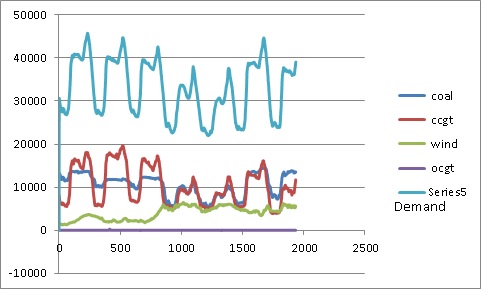A word on Intermittency
Those opposed to renewable`s talk about the energy grid as if it would gallop along smoothly using nuclear and fossil fuels all operating at 100% capacity factor with no need for excess capacity or spinning reserves if it weren’t for those pesky wind mills! Now intermittency and the inability to turn up wind power and some other renewable`s (hydro and biomass for example are what we call dispatchable) is an issue but it isn’t anywhere like the issue that the antis make out. Recently Wind set new generation records and so I went on to the gridwatch site and managed to download a week’s worth of figures for wind and some of the important fossil fuels. Here they are:
So what does this tell us?
- During the week covered wind did indeed set new records providing more than 5GW pretty much continuously through Saturday and Sunday.
- There is a marked difference between the wind output during Wed-Friday and that over the weekend and into Monday but the variation within those extended periods is relatively minor and the ramp between them is not especially steep.
- The Demand curve shows massive changes with huge ramp rates.
- CCGT is dealing with the changes in demand by changing its output very rapidly and coal is also being made to contribute some balancing changes.
- OCGT is hardly used at all only coming into use briefly during the Thursday am peak (Just below 500 on the X axis).
What does this mean?
- Wind is not adding to the problems of peaking and balancing in a significant way. This is dominated by the behaviour of the demand curve.
- Assuming reasonably accurate 24 hour weather forecasting the output of wind should be predictable to a good level of accuracy sufficiently far in advance to schedule fossil fuel plants to be off-line and therefore genuinely reduce CO2 output. As the size of the wind fleet grows the variation in wind output decreases as the averaging effect of a numerically large fleet spread across the country kicks in – wind never just instantaneously disappears. Minor variations in wind output will be easily accommodated in the balancing flexibility of CCGT already needed to account for variation in demand.
- Wasteful OCGT is not being used in large quantities undermining wind carbon savings.
- The curves for CCGT and coal have been effectively lowered by the presence of wind without increasing the ramp rates that they have to follow. This means that a genuine saving in CO2 emissions is the result.

